On test: Cold water pressure washers – which is best?
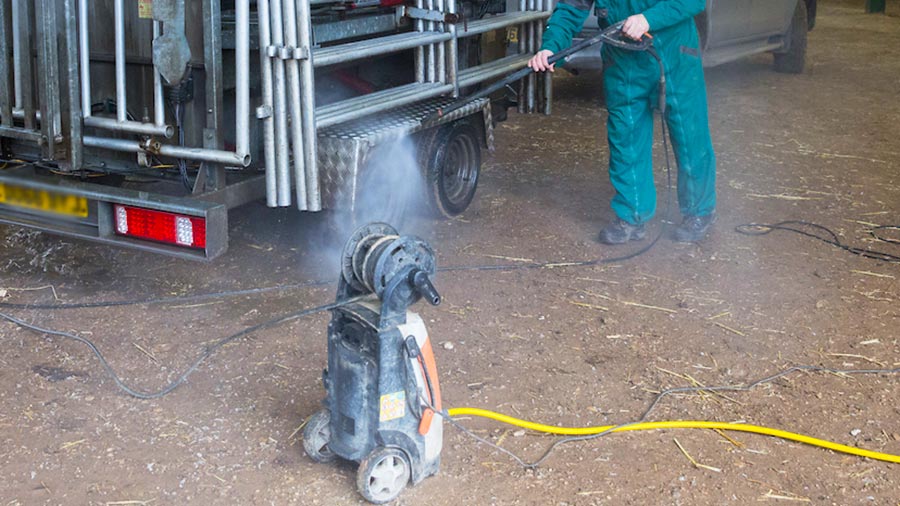 © Tim Scrivener
© Tim Scrivener Having a decent, easily portable pressure washer about the farm is always handy but, increasingly, it seems that what you buy doesn’t always measure up to expectations.
We put five of the front-runners to the test, asking the suppliers to provide the model best suited to agriculture.
While initial assessments were all about ease of assembly and operation, ultimately the quality of the job they do is down to how much water they can pump out and the force of the jet coming out of the lance.
To delve a bit deeper we took measurements of pressure and flow, enabling us to compare our real world figures with those quoted by the manufacturers.
See also: 12 reusable farm gloves on test: Which are best?
The tests
We put all five pressure washers through the same bank of simple tests, as well as scoring them with our own subjective assessments.
First up we timed how long it took to get them from their unboxed state to being ready for work.
Then we measured hose and cable lengths and worked out how the various chemical application systems work.
Next job was to plumb in our pressure testing gauges to record the force of water running through the lance with the trigger depressed.
This was intended to compare each machine with its competitors, but also with the manufacturers’ rated outputs.
Without exception, all five quoted figures were well in excess of what we recorded – suggesting that bench-testing the pumps at full unrestricted flow will give a very different result to the actual force of water coming out of the nozzle.
But pressure is only one part of the story. The volume of water each machine is capable of producing has a big overall impact on its ability to dislodge grease and grime.
That’s a whole lot easier to measure – we simply collected the water pumped out of the lance over a minute, giving us a figure to compare with the manufacturers’ ratings.
Once again, what we recorded was well down on the paper stats across the board, highlighting that a full-flow measurement taken at the pump outlet will be significantly different to what actually comes out of the nozzle.
To ensure a level playing field on the inlet side, we used a 1,000-litre IBC tank raised on pallet forks to 4m to provide a reliable head of pressure for the tests, negating any spikes or drops that might skew our measurements.
These records are accompanied by our general observations about build quality, controls, hose, cable, lance and nozzle stowage as well as how comfortable the gun felt in the hand after 15 minutes’ work.
Karcher HD 7/12-4M Cage
3/5
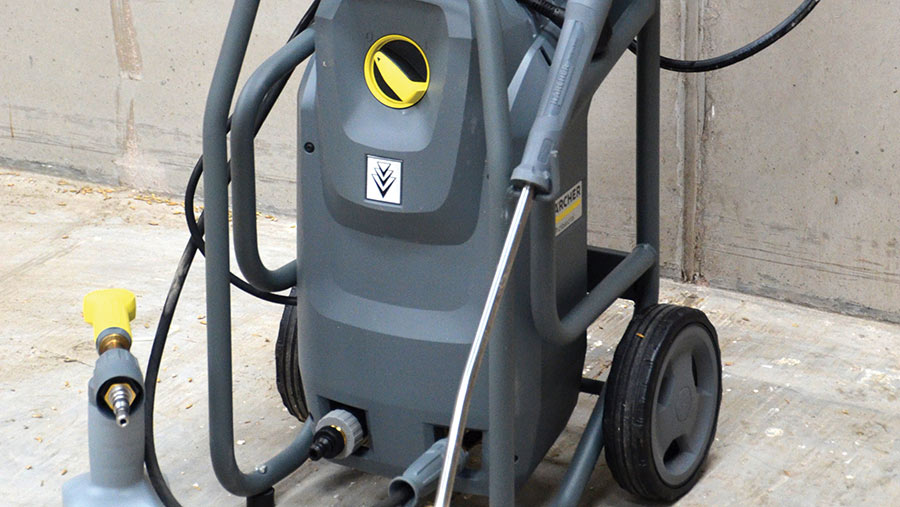
© Nick Fone
Best for Most powerful, highest pressure.
Assembly time 20mins. Spanners needed to fit quick connectors to lance and hose, inlet filter and Hozelock connector.
Lance The Karcher had the best lance. Rather than a traditional finger trigger, the back of pistol grip is depressed with the heel of your hand.
This minimises fatigue and, once running, recoil from the lance keeps the trigger engaged without any effort. It comes with two hooks to balance the lance on and a clip-fit nozzle holder. 4.5/5
Hose 9.5m. No stowage. Karcher uses its own proprietary double-thread fittings so repairs/non-genuine replacements are not an option.
Cable 5m. No stowage.
Controls One simple rotary on/off switch.
Service access Four Torx screws hold down the cover, but vital components are still virtually inaccessible. No oil dipstick or sight glass. 1/5
Chemical application Detergent/disinfectant additive bottle attaches to the lance quick-coupler, but has no rate adjustment and no stowage.
Lance comes with flat fan nozzle and spinning pencil jet.
Build quality 4/5
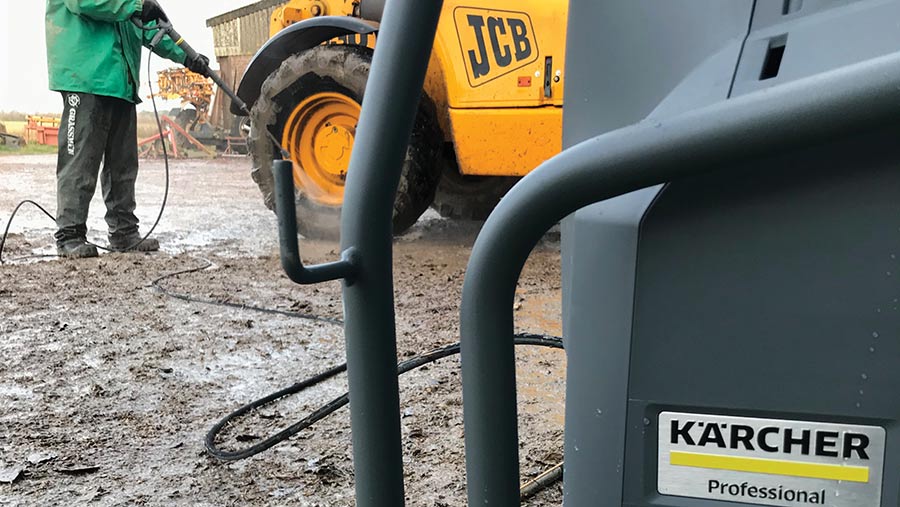
© Nick Fone
FW Verdict
As the most powerful unit we tested, the Karcher should have been our stand-out favourite, but is let down by a design that makes it almost impossible to service or repair.
The complete absence of stowage for the hose, cable or foam gun is a pain, because they’re likely to be left on the deck to be driven over or trodden on.
List price £1,210.39
Best online price £1,125 A1 Pressure Washers
Kranzle Quadro 11/140 TST
4/5
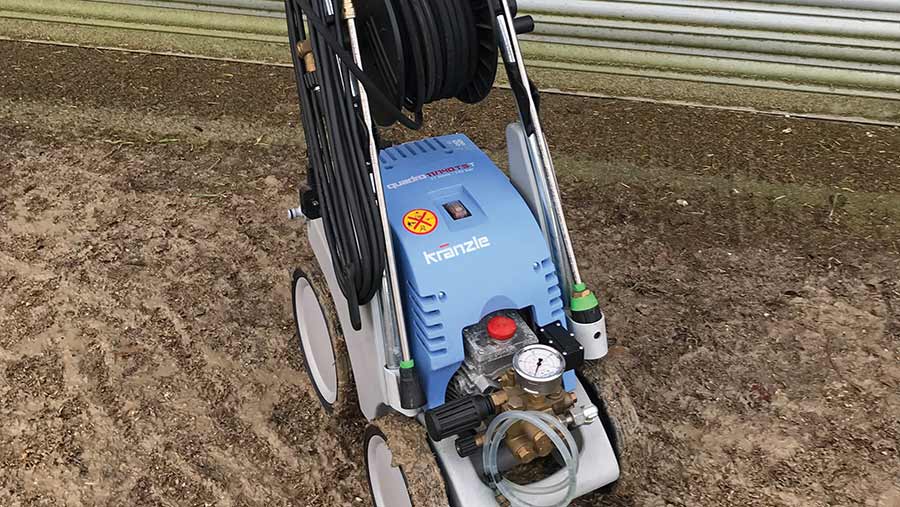
© Nick Fone
Best for Biggest volume of water produced, joint quietest.
Assembly Ready assembled – just connect one of the two nozzles and plumb it in.
Lance Two-piece unit with 60cm-long interchangeable lance/nozzle attached to the gun with solid-feeling quick couplers. Clip brackets for two lower lances. 3/5
Hose 15m. Decent hose reel. Standard M22 fine-thread fittings, meaning replacements can be easily sourced.
Cable 5.5m. Fixed hook stowage.
Controls Slightly awkward on/off rocker switch. Easy-to-adjust rotary regulators to vary output pressure and chemical rate, and it has an accurate pressure gauge.
Service access Much of the pump is exposed, with a one-piece plastic cover to remove and a proper dipstick for checking the oil level. 4/5
Chemical application Two options – an induction hose to draw detergent/disinfectant up out of a separate can for high-pressure work, and a foam gun on a lance quick-connector for low-pressure coverage.
Rather than being positioned in the high-pressure line, the detergent/disinfectant intake is on the inlet side of the pump.
According to Kranzle, this avoids choking the outlet line, with the result that the machine delivers full pressure even when applying chemical.
It also means awkward nooks and crannies can be cleaned at high pressure while applying disinfectant – a plus point in livestock sheds.
Build quality 4/5
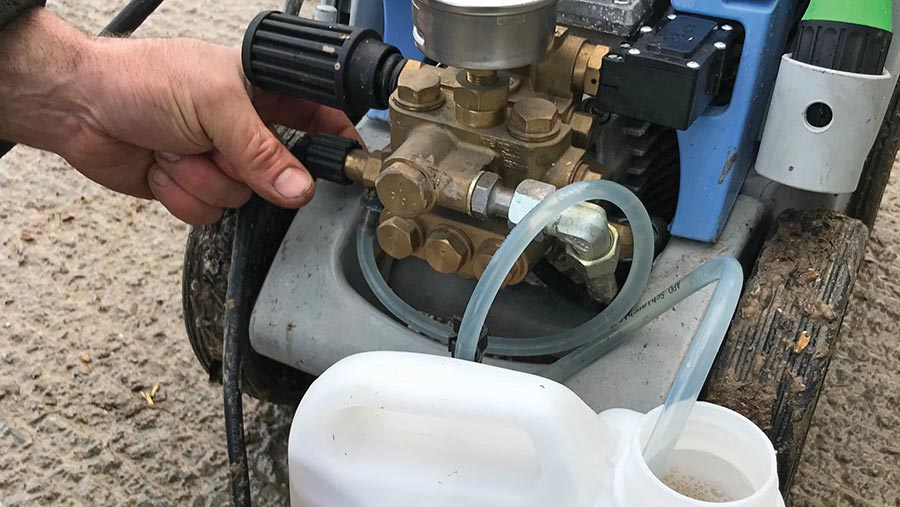
© Nick Fone
FW Verdict The Kranzle’s integrated header tank provides a buffer of water when attached to a low-pressure supply but is also an area for potential complication with its mini ballcock and additional plumbing.
Two options for detergent/disinfectant application and full-on adjustability of pressure, flow and chemical rate make it the most complete package, albeit the most complex.
However, it is heavy and the four-wheel design doesn’t make for the most compact unit.
List price £1,090 (£1,215 as tested with hose reel and spinning turbo nozzle)
Best online price £999 bgclean.co.uk
Nilfisk MC 4M 140/620 XT
4.5/5 (Editor’s pick)
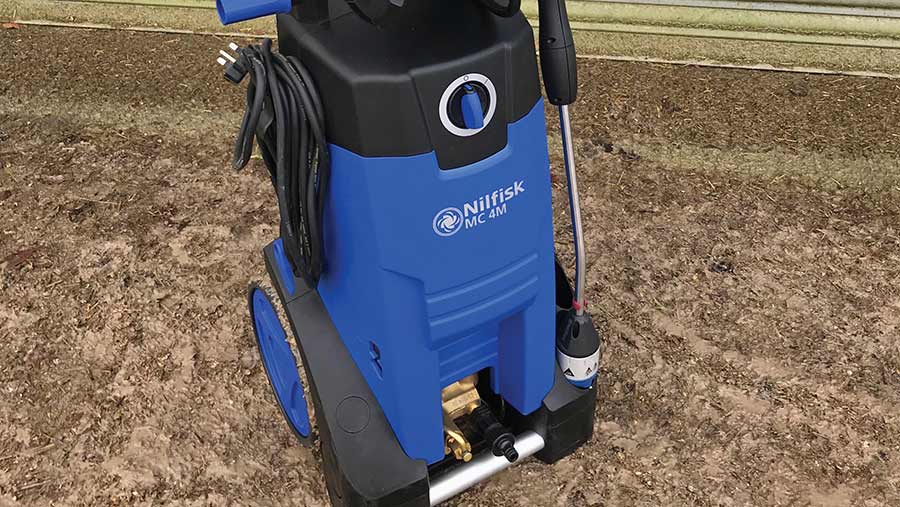
© Nick Fone
Best for Most user-friendly, joint quietest.
Assembly Took just over two minutes. Extremely straightforward – simply attach the handle to the winder and connect the lance to the hose.
Lance Single rotating nozzle twists to select different spray patterns, making it a little nose-heavy as a result. Quick coupler to remove lance from gun and attach foam gun/chemical applicator.
Lance clicks into vertical storage clips, and there is a dedicated foam gun bracket. 4/5
Hose 15m. Decent hose reeler. Uses 3/8 BSP fittings which are readily available for easy repairs.
Cable 5.5m. Tidy cable stowage hooks with quick-release swivel and plug clip.
Controls Single rotary on/off switch.
Service access Clear oil sight gauge. One-piece plastic cover and plastic twist locks can be removed with a coin to access oil filler. 4/5
Chemical application Quick-attach foam gun.
Build quality 4/5
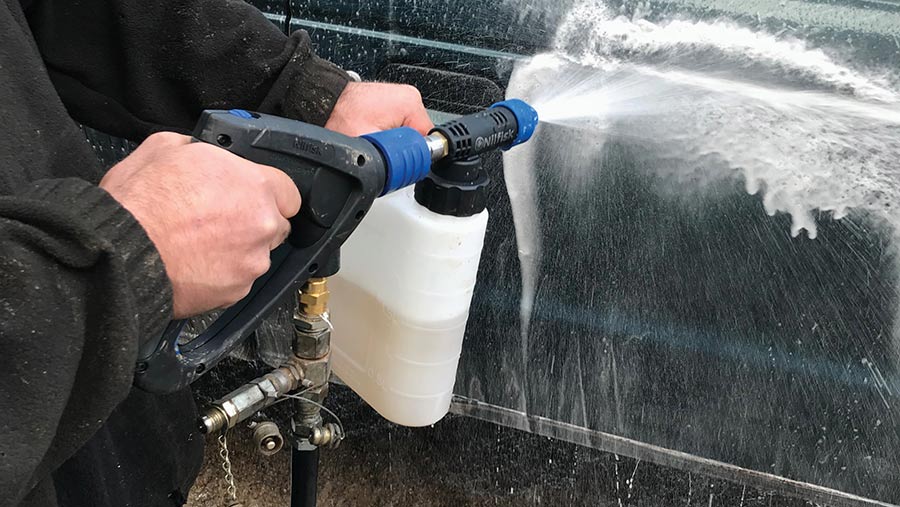
© Nick Fone
FW Verdict
We like the Nilfisk’s straightforward set-up. One simple on/off switch and away you go, with no need to alter pressures for chemical application.
Lance design is simple with a rotating nozzle to select spray patterns. The only downside is that it’s slightly nose heavy.
List price £900
Best online price £657.33 Avern Industrial Cleaning
Sealey PW5000
2/5
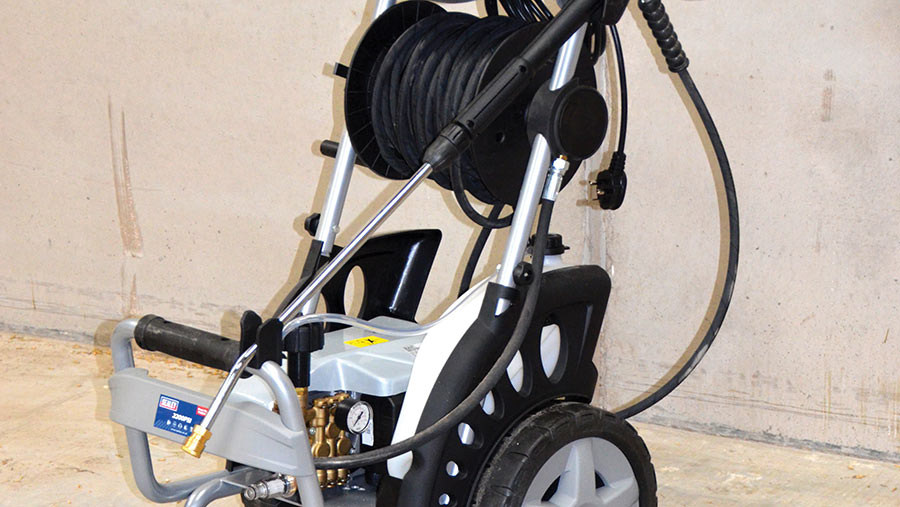
© Nick Fone
Best for Biggest nozzle choice.
Assembly Bolt on the handle and hose reel winder, wind in and tighten the threaded hose connectors, and away you go.
Lance Lightweight and not particularly sturdy. Five colour-coded, quick-couple nozzles for different spray patterns are stored in dedicated rack on the handle. 2/5
Hose 15m. Good reel. Standard 1/4in BSP fittings are readily available, making for easy repairs.
Cable 5.2m. Simple hooks for flex stowage.
Controls Rocker switch feels less than positive. Rotary valve to adjust pressure/flow with analog gauge.
Service access Very easy access because the most critical components are exposed.
Has a proper dipstick for pump oil level, plus a clear plastic Hozelock connector with removable inlet strainer. 4/5
Chemical application Induction through the pump from an awkward-to-fill onboard tank.
Requires switching to low-pressure nozzle to draw up the chemical, with the result that it has little cleaning power when applying detergent/disinfectant.
Chemical rate adjusted via swivelling filler cap.
Build quality 2/5
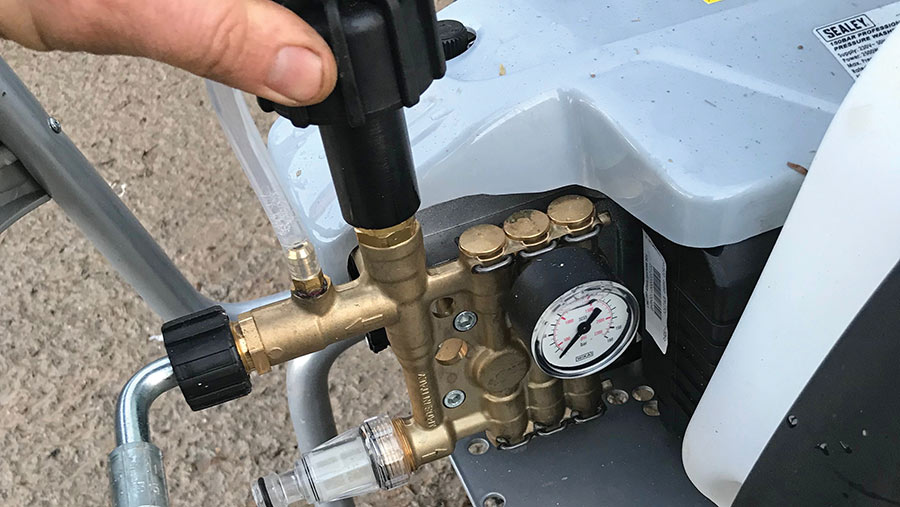
© Nick Fone
FW Verdict
Both the motor and pump are by far the smallest we tested, and that’s reflected in the Sealey’s output which was well down on what’s quoted on the spec sheet.
Overall build feels flimsy but it doesn’t lack in functionality, with interchangeable nozzles, decent stowage and adjustability.
List price £1,139.95
Best online price £751.67 FFX
Stihl RE150 Plus
2.5/5
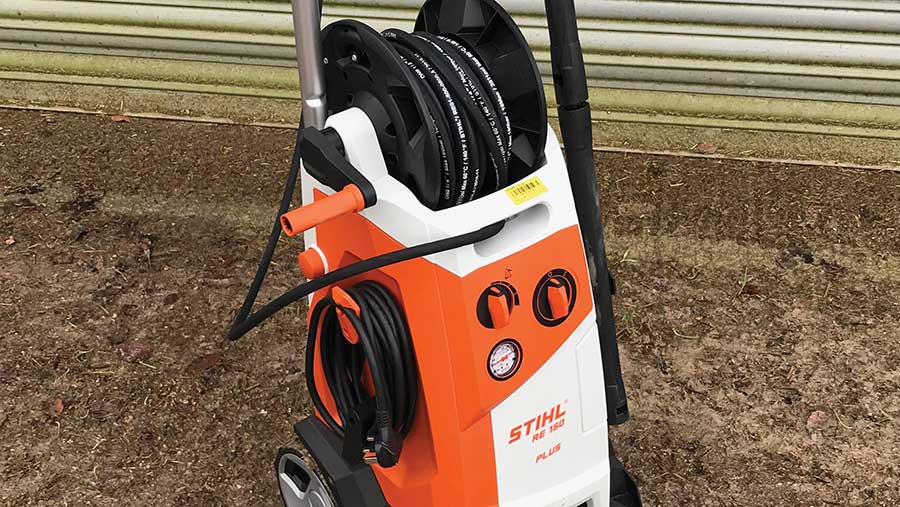
© Nick Fone
Best for Hose reel, cable and lance stowage.
Assembly Ready assembled.
Lance Two-piece plastic lance feels flimsy. Bayonet fittings for split shaft and different nozzles – adjustable flat-fan and spinning pencil jet.
Features a neat hidden storage compartment for two nozzles and a clean-out pick. Clip-fit lance holder. 2/5
Hose 11.5m. Slick reel with hose guide rail. Stihl’s own quick-coupler fittings means there’s no opportunity for cheap and easy repairs.
Cable 5m. Cable hooks with quick-release swivel and plug clip.
Controls Comprehensive. Pressure/flow control is set with a rotary valve on the side of the unit. Pressure gauge gives an indication of outlet water force.
Rotary adjuster for chemical induction rate and on/off switch.
Service access Virtually non-existent. Requires full dismantling of all plastic shrouds. 1/5
Chemical application Onboard tank unclips for filling. Chemical rate is controlled by a dial on the front of the unit.
For this, the flat-fan nozzle needs to be wound fully open and the pump set to maximum pressure, giving reasonable cleaning power while applying detergent/disinfectant.
Build quality 4/5
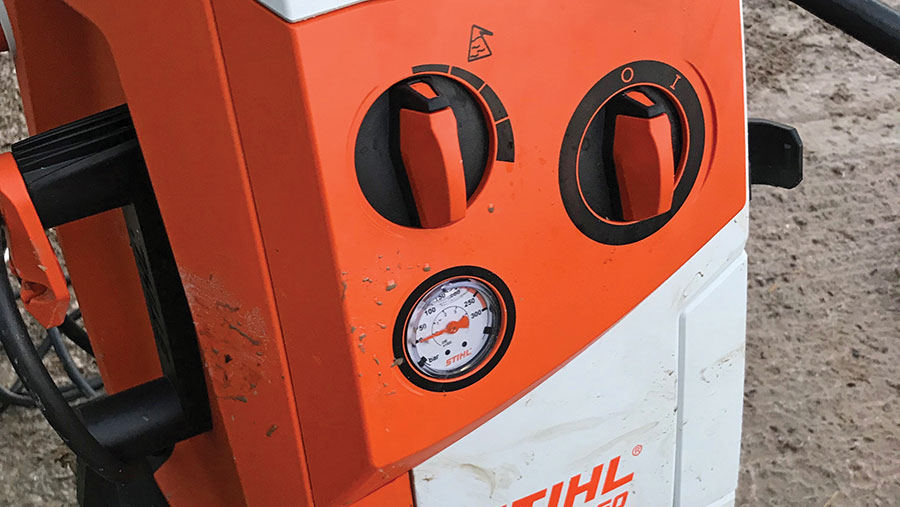
© Nick Fone
FW Verdict
A nicely designed unit, Stihl’s flagship pressure washer is let down by the hardware behind the stylish panelwork.
Like the Sealey, both tested pressure and flow were well down on the manufacturer’s rated figures.
Controls and stowage are by far the best thought-out, and the extendable aluminium handle and folding hose reel winder make for a very compact package when not in use.
List price £562.50
Best online price N/A (not launched until February 2021).
Specifications and results |
|||||
|
Karcher HD 7/12-4M Cage |
Kranzle Quadro 11/140 TST |
Nilfisk MC 4M 140/620 XT |
Sealey PW5000 |
Stihl RE150 Plus |
|
|
Rated pressure* |
180bar (2,610psi) |
140bar (2,030psi) |
140bar (2,030psi) |
135bar (1,958psi) |
128bar (1,856psi) |
|
Tested pressure |
141bar (2,050psi) |
107bar (1,550psi) |
114bar (1,650psi) |
89bar (1,300psi) |
86bar (1,250psi) |
|
Rated flow* |
11.7 litres/min |
11 litres/min |
9.3 litres/min |
8.3 litres/min |
10.2 litres/min |
|
Tested flow |
10.3 litres/min |
10.5 litres/min |
8.8 litres/min |
6.9 litres/min |
7.9 litres/min |
|
Noise |
86dBa |
81dBa |
81dBa |
83dBa |
82dBa |
|
Motor power* |
3.1kW |
3.0kW |
2.9kW |
2.5kW |
2.8kW |
|
Base list price |
£1,210.39 |
£1,090 |
£900 |
£1,139.95 |
£562.50 |
| * Manufacturers’ figures | |||||
Accessories and attachments
Most manufacturers offer a plethora of bits and pieces that you can couple up to a pressure washer, from chemical applicator foam guns to spinning pencil jet nozzles.
The former make for a straightforward, uncomplicated way to apply detergent or disinfectant. Generally, they work best when you can dial down the water pressure to avoid blasting away the very product you want to apply.
Typically interchangeable for standard flat-fan nozzles, spinning pencil jets are claimed to increase the cleaning power of pressure washers on uneven surfaces.
The principle behind this is that a single needle jet of water concentrates the pressure produced at one spot.
Making this jet spin in a cone pattern supposedly gives the coverage of a fan but with greater power.
While this might be the case on stippled surfaces, in our test we found the blade-like action of standard flat-fans was equally effective in shifting stubborn muck and grease on the various trucks, tractors and telehandlers in the yard.
An optional extra from most makers, drain jetting nozzles can extend the working capabilities of cold-water machines.
Kranzle UK was good enough to include one in the box for us to try.
Its three rearward-facing jets produced a huge amount of forward thrust, and were able to shift decent chunks of lumpy silt.
The only limitation of such an arrangement is hose length.

